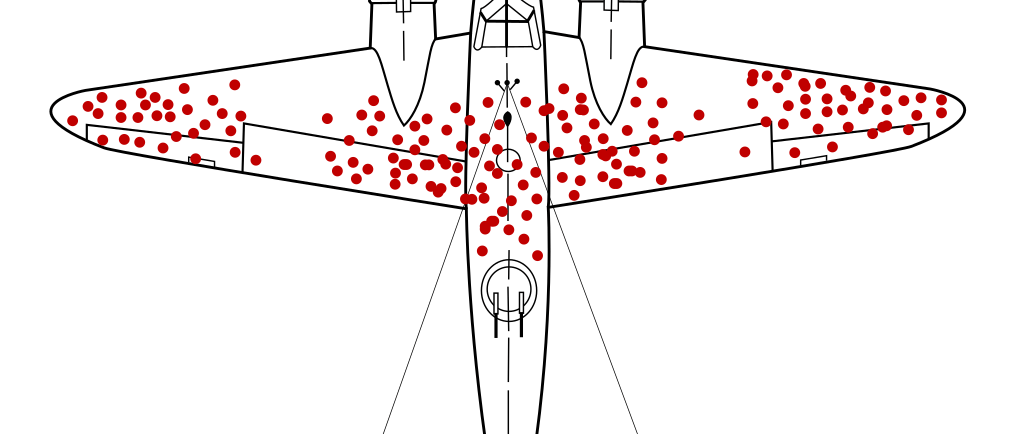Survivorship Bias: Using Accounting Goodwill to Estimate Intangible Property Values
This article draws an insightful parallel between the flawed analysis of military planners during World War II and the potential pitfalls of using accounting goodwill to estimate intangible personal property value. It highlights the dangers of survivorship bias and overreliance on limited data. The author advocates for a more comprehensive approach, incorporating diverse valuation methods and considering companies that have ceased operations, to achieve a robust and reliable analysis. Readers are encouraged to explore alternative techniques like the excess earnings method while being mindful of inherent assumptions.tion.
Scott Sampson
5/7/20243 min read


It was a beautiful late July day in Seattle, the kind that locals yearn for throughout the gray months. Ferry boats cross Puget Sound loaded with tourists and commuters. The Cascade Mountains boast their snowy crowns to the east and the Olympic Mountains stand sentinel to the west. It’s a day where business and pleasure coalesce. The property tax consultants marvel at this beauty before they walk in to my conference room. Their laptops loaded with their finely crafted PowerPoint presentation and analysis of goodwill value. However, unbeknownst to them, their analysis contained a significant flaw, a flaw made by military planners in World War II that nearly doomed many pilots and their crews.
The analysis of Allied military aircraft that returned from combat missions during World War II presented a challenge in understanding the true nature of damage sustained by these planes. Initially, the focus was on the areas that exhibited heavy damage, such as the wings, tail, and center of the body (Figure 1). The military's plan was to add armor to these regions to prevent further damage. However, this approach overlooked a crucial insight.
Abraham Wald, a Columbia University mathematician was hired to assist with the study. Wald's keen observation led him to recognize that the military's approach was misguided. They were solely considering the planes that survived combat and returned, which provided an incomplete picture. The planes that did not return likely sustained fatal hits in areas other than those observed on the surviving aircraft.
With this realization, Wald made a groundbreaking assumption. He proposed that the military should focus on adding armor to the portions of the returning aircraft that bore the least damage. His reasoning was that these undamaged areas likely corresponded to the points where fatal hits had occurred on the downed planes, leading to their loss during combat missions.
Wald's insight revolutionized the military's approach to aircraft protection, shifting the focus from the visible damage on survivors to the unseen vulnerabilities revealed by the absence of damage. This counterintuitive yet logical perspective ultimately improved the survivability of Allied aircraft and demonstrated the value of looking beyond the obvious when analyzing complex problems.
When using accounting goodwill in the valuation analysis to estimate tax-exempt intangible personal property value, the tax consultants fell into the trap of survivorship bias, much like the military planners who analyzed the damage patterns on returning aircraft during World War II.
Just as the military focused only on the planes that survived combat missions, the tax consultants considered only existing or "surviving" companies in their analysis. By excluding companies that have ceased to exist, whether due to acquisition, merger, or bankruptcy, the consultants overlooked a crucial segment of the data.
This approach mirrors the flawed reasoning of the military planners, who failed to account for the aircraft that did not return from combat missions and the potential damage patterns that led to their demise. Similarly, by disregarding companies that have ceased to exist, the tax consultants inadvertently introduced bias into their analysis.
Companies that have ceased to exist may have exhibited different characteristics or experienced different outcomes, which could have significant implications for the valuation analysis. By excluding these companies, the consultants effectively ignored a subset of the data that could potentially reveal valuable insights or highlight vulnerabilities that contributed to their failure or acquisition.
Moreover, relying solely on accounting goodwill as a measure of tax-exempt intangible personal property value carries additional problems beyond survivorship bias. Accounting practices and valuation methods can vary across companies and industries, introducing inconsistencies and potential distortions in the analysis. Furthermore, goodwill may not accurately capture the full scope of intangible assets, as some intangible assets may not be recognized or properly valued in financial statements.
To avoid the pitfalls of survivorship bias and achieve a more comprehensive and accurate valuation analysis, it is crucial to consider a broader range of data, including companies that have ceased to exist. Additionally, complementing the analysis with other valuation methods and accounting for potential biases and limitations in the data can provide a more robust and reliable estimate of tax-exempt intangible personal property value.
For example, excess earnings methods can be used to estimate a company's intangible personal property value by analyzing the portion of a company's earnings that exceed a normal return on its tangible assets. The underlying principle is that any earnings above a reasonable return on tangible assets can be attributed to the company's intangible assets, such as intellectual property, brand recognition, customer relationships, and goodwill. However, it's important to note that the method relies on several assumptions and estimates, such as the required rate of return, capitalization rate, and the separation of earnings between tangible and intangible assets. Therefore, the results should be interpreted with caution and potentially validated with other valuation methods.
If you require assistance in valuing your company's intangible personal property or exploring alternative valuation methods, contact Sampson Valuation Consulting. We can guide you through the process, ensuring a comprehensive and accurate analysis that avoids the pitfalls of survivorship bias and other common pitfalls. Don't let biased or incomplete data undermine your valuation efforts. Reach out to us today to leverage our expertise and safeguard the integrity of your valuation.
